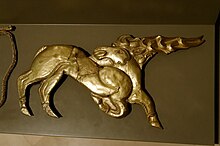Eurasian nomads
| Part of a series on |
| Indo-European topics |
|---|
 |

The Eurasian nomads were a large group of nomadic peoples from the Eurasian Steppe, who often appear in history as invaders of Europe, the Middle East and China.
The generic title encompasses the varied ethnic groups who have at times inhabited the steppes of Central Asia, Mongolia, and what is now Russia. They domesticated the horse around 3500 BC, vastly increasing the possibilities of nomadic life,[1][2][3] and subsequently their economy and culture emphasised horse breeding, horse riding and nomadic pastoralism; this usually involved trading with settled peoples around the steppe edges. They developed the chariot, wagon, cavalry and horse archery and introduced innovations such as the bridle, bit and stirrup, and the very rapid rate at which innovations crossed the steppelands spread these widely, to be copied by settled peoples bordering the steppes.
"Horse people" is a generalized and somewhat obsolete term for such nomads, which is also sometimes used to describe hunter-gatherer peoples of the North American prairies and South American pampas who started using horses after the Europeans brought them to the Americas.
History
Early periods in Chinese history involved conflict with the nomadic Rong and Xiongnu peoples to the west of the Wei valley. Iron and bronze was supplied from China.[4] Scythia was a loose state or federation covering most of the steppe that originated as early as 8th century BC, composed mainly of people speaking Iranian languages, and usually regarded as the first of the nomad empires. The Roman army hired Sarmatians as elite cavalrymen. Europe was exposed to several waves of invasions by horse people, from the Cimmerians in the 8th century BCE, down to the Migration period and the Mongols and Seljuks in the High Middle Ages, the Kalmuks and the Kyrgyz and later Kazakhs, down into modern times. The earliest example of an invasion by a horse people may have been by the Proto-Indo-Europeans themselves, following the domestication of the horse in the 4th millennium BCE (see Kurgan hypothesis). Cimmerian is the first invasion of equestrian steppe nomads that is known from historical sources. Their military strength was always based on cavalry, usually marked by prowess as mounted archers. Kurgan is a general term for steppe burial mounds, which sometimes contained very elaborate burials.
The concept of "horse people" was of some importance in 19th century scholarship, in connection with the rediscovery of Germanic pagan culture by Romanticism (see Viking revival), which idealised the Goths in particular as a heroic horse-people. J. R. R. Tolkien's Rohirrim may be seen as an idealised Germanic people influenced by these romantic notions. Tolkien's Wainriders of eastern Rhûn recall ancient steppe peoples like the Scythians. Similarly, George R. R. Martin's nomadic Dothraki people are heavily influenced by the lifestyles and cultures of historical horse people.[citation needed]
Nomadism persists in the steppelands, though it has generally been disapproved of by modern regimes, who have often discouraged it with varying degrees of coersion.
a Perhaps a Sprachbund.
Chronological division
Chronologically, there have been several "waves" of invasions of either Europe, the Near East, India and/or China from the steppe.
- Bronze Age
- Proto-Indo-Europeans, see Indo-European migrations, Kurgan theory, and the later Indo-Aryan migration theory
- High Middle Ages to Early Modern period
- Mongol Empire and continued Turkic expansion:
See also
By region
References
- ^ Matossian Shaping World History p. 43
- ^ "What We Theorize – When and Where Domestication Occurred". International Museum of the Horse. Retrieved 2015-01-27.
- ^ "Horsey-aeology, Binary Black Holes, Tracking Red Tides, Fish Re-evolution, Walk Like a Man, Fact or Fiction". Quirks and Quarks Podcast with Bob Macdonald. CBC Radio. 2009-03-07. Retrieved 2010-09-18.
- ^ Susan E. Alcock (9 August 2001). Empires: Perspectives from Archaeology and History. Cambridge University Press. pp. 19–. ISBN 978-0-521-77020-0.
Bibliography
- Amitai, Reuven; Biran, Michal (editors). Mongols, Turks, and others: Eurasian nomads and the sedentary world (Brill's Inner Asian Library, 11). Leiden: Brill, 2005 (ISBN 90-04-14096-4).
- Drews, Robert. Early riders: The beginnings of mounted warfare in Asia and Europe. N.Y.: Routledge, 2004 (ISBN 0-415-32624-9).
- Golden, Peter B. Nomads and their neighbours in the Russian Steppe: Turks, Khazars and Qipchaqs (Variorum Collected Studies). Aldershot: Ashgate, 2003 (ISBN 0-86078-885-7).
- Hildinger, Erik. Warriors of the steppe: A military history of Central Asia, 500 B.C. to A.D. 1700. New York: Sarpedon Publishers, 1997 (hardcover, ISBN 1-885119-43-7); Cambridge, MA: Da Capo Press, 2001(paperback, ISBN 0-306-81065-4).
- Kradin, Nikolay. 2004. Nomadic Empires in Evolutionary Perspective. In Alternatives of Social Evolution. Ed. by N.N. Kradin, A.V. Korotayev, Dmitri Bondarenko, V. de Munck, and P.K. Wason (p. 274–288). Vladivostok: Far Eastern Branch of the Russian Academy of Sciences; reprinted in: The Early State, its Alternatives and Analogues. Ed. by Leonid Grinin et al. (р. 501–524). Volgograd: Uchitel'.
- Kradin, Nikolay N. 2002. Nomadism, Evolution, and World-Systems: Pastoral Societies in Theories of Historical Development. Journal of World-System Research 8: 368–388.
- *Kradin, Nikolay. 2003. Nomadic Empires: Origins, Rise, Decline. In Nomadic Pathways in Social Evolution. Ed. by N.N. Kradin, Dmitri Bondarenko, and T. Barfield (p. 73–87). Moscow: Center for Civilizational Studies, Russian Academy of Sciences.
- *Kradin, Nikolay. 2006. Cultural Complexity of Pastoral Nomads. World Cultures 15: 171–189.
- Kradin, Nikolay. Nomads of Inner Asia in Transition. Moscow: URSS, 2014 (ISBN 978-5-396-00632-4).
- Littauer, Mary A.; Crouwel, Joost H.; Raulwing, Peter (Editor). Selected writings on chariots and other early vehicles, riding and harness (Culture and history of the ancient Near East, 6). Leiden: Brill, 2002 (ISBN 90-04-11799-7).
- Shippey, Thomas "Tom" A. Goths and Huns: The rediscovery of Northern culture in the nineteenth century, in The Medieval legacy: A symposium. Odense: University Press of Southern Denmark, 1981 (ISBN 87-7492-393-5), pp. 51–69.
External links
- Nomadic Art of the Eastern Eurasian Steppes, an exhibition catalog from The Metropolitan Museum of Art (fully available online as PDF), which contains material on Eurasian nomads
- Center for the Study of Eurasian Nomads
